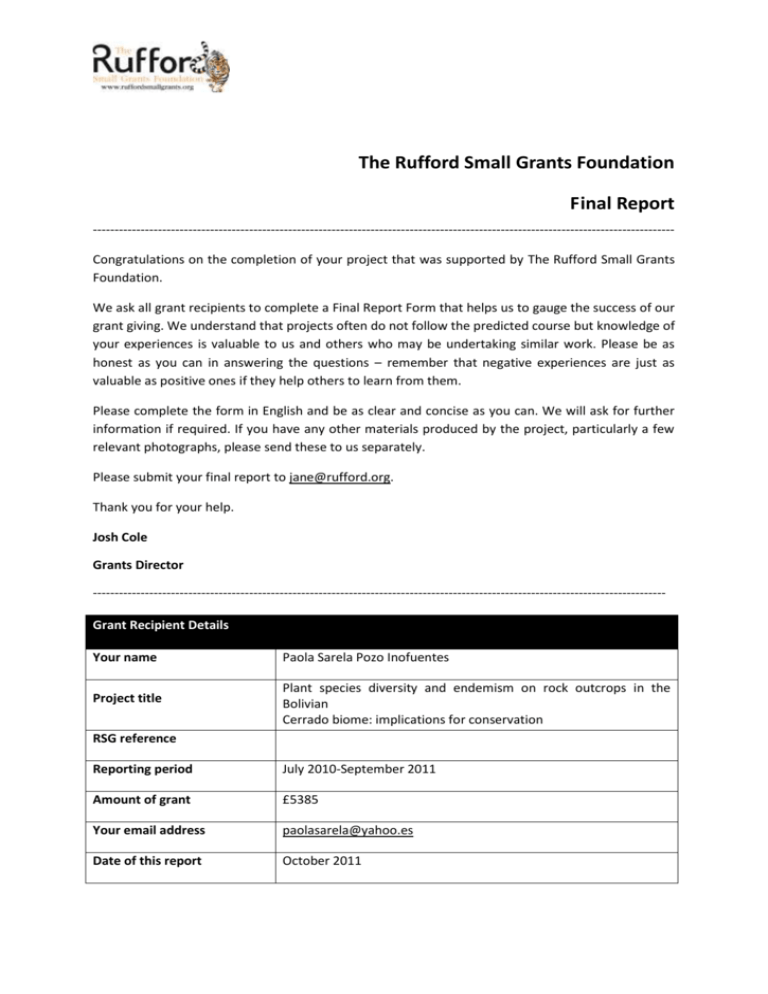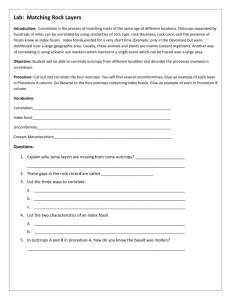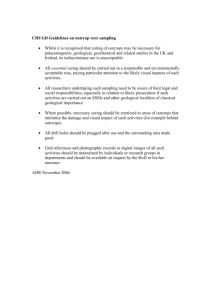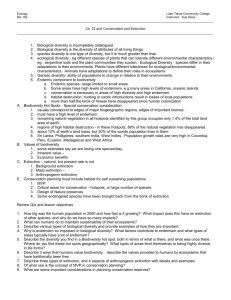Final Report - The Rufford Foundation
advertisement

The Rufford Small Grants Foundation Final Report -------------------------------------------------------------------------------------------------------------------------------------Congratulations on the completion of your project that was supported by The Rufford Small Grants Foundation. We ask all grant recipients to complete a Final Report Form that helps us to gauge the success of our grant giving. We understand that projects often do not follow the predicted course but knowledge of your experiences is valuable to us and others who may be undertaking similar work. Please be as honest as you can in answering the questions – remember that negative experiences are just as valuable as positive ones if they help others to learn from them. Please complete the form in English and be as clear and concise as you can. We will ask for further information if required. If you have any other materials produced by the project, particularly a few relevant photographs, please send these to us separately. Please submit your final report to jane@rufford.org. Thank you for your help. Josh Cole Grants Director -----------------------------------------------------------------------------------------------------------------------------------Grant Recipient Details Your name Paola Sarela Pozo Inofuentes Project title Plant species diversity and endemism on rock outcrops in the Bolivian Cerrado biome: implications for conservation RSG reference Reporting period July 2010-September 2011 Amount of grant £5385 Your email address paolasarela@yahoo.es Date of this report October 2011 1. Please indicate the level of achievement of the project’s original objectives and include any relevant comments on factors affecting this. Fully achieved Partially achieved Not achieved Objective Generate information about plant diversity and endemism on rock outcrops in the serranías of Roboré and Concepción √ Generate data about the distribution and population status of at least 10 endemic and/or restricted plant species, on rock outcrops in the serranías of Roboré and Concepción. √ Identify threats to species survival and provide conservation recommendations √ Raise awareness among local people, the scientific community and the policy makers about the importance of rock outcrops as hotspots of plant diversity and endemism √ Comments Originally, we aimed to study 20 rock outcrops overall. Fortunately, we could increase the number of surveys until 25. The surveys include areas of rock platforms, rock towers, granite domes and campos rupestres. In each area, botanical surveys were carried out in dry and wet seasons, with this information we have acquired data about diversity and endemism of plants on rock outcrops. Our results highlight the importance of rock outcrops in terms of endemism and biodiversity of plants. Specifically, the rock outcrops in the serranías of Roboré where we found more than 30 endemic plant species, including at least two new species for science. In each area we established five plots systematically replied (90 plots in total) where we studied distribution and population patterns (density, frequency, spatial patron, population structure) of endemic and/or restricted plant species. Originally we aimed to study at least 10 species. Fortunately, we could increase the number to 22. The information generated will help determine the conservation status of endemics using the IUCN red list categories and criteria. By field observations and conversations with local people we collected information about potential threats to the survival of endemic and/or restricted plant species. We will use this information to assess the conservation status using the IUCN red list categories and criteria. We elaborate posters, scientific publications and reports for the local and scientific community about the importance of rock outcrops as hotspots of plant diversity and endemism. We could perceive an increase of enthusiasm of local and scientific communities in the conservation and research process. We are preparing a detailed report of our results to policy markers. There is more information left about our results that is being analyzed and that will be published in a near future. 2. Please explain any unforeseen difficulties that arose during the project and how these were tackled (if relevant). There were no relevant difficulties. Some irrelevant difficulties include waiting longer than expected for the permission of biodiversity authorities to carry out our research purposes. 3. Briefly describe the three most important outcomes of your project. The project made a long lasting contribution to nature conservation. We assembled and left behind a large body of data and a reference collection of plants from rock outcrops for ongoing development, future conservation initiatives and future biodiversity work. We characterise Bolivian rock outcrops in the serranías of Roboré and Concepción. We assessed information about distribution and population status of 22 endemic and/or restricted plant species and also evaluated actual and potential threats to their survival. This information is going to be used to determine the conservation status of this species. By working with local communities we stimulate collaboration between scientific research and local people in the conservation and research process. We were able to experience the enthusiasm of local communities and scientific community with our studies. This study therefore, made a substantial and long-lasting contribution to nature conservation. 4. Briefly describe the involvement of local communities and how they have benefitted from the project (if relevant). This project has employed local guides for the studies. During the research local guides have undergone capacity building; they learned how to conduct botanical surveys, scientific names of important plant species and camera trapping skills. The local community around the field has also expressed interest in our research, they asked our team to continue with the workshops focus on children and young people, teaching them classify families and species of plants in order to contribute to the conservation process. We have distributed printed material to the community and we plant to include more workshops in the following months. 5. Are there any plans to continue this work? We plan to continue the project focus on local communities. In our project area local communities have limited scientific knowledge on the biodiversity of the area and they have shown enthusiasm to have scientific training. We plan to continue with workshops to develop the capacity to understand the concepts, principles, and techniques to study biodiversity and to participate in the conservation and research process. Personally, I expect to continue doing research in this area at a post grade level. 6. How do you plan to share the results of your work with others? The project has shared the results in format of presentations at scientific meetings. For instance, the results of the project are going to be presented in the III Bolivian Congress of Ecology. Moreover, we wrote two papers that are now in review and we plant to write at least one more paper about other data generated by the project. Local communities have received printed material and at the end of the year we plant to present a detailed final report of our results to national and local authorities. 7. Timescale: Over what period was the RSG used? How does this compare to the anticipated or actual length of the project? The project was carried out for a period of 15 months (July 2010 – September 2011). This is about 2 months more as compared to the original plan. The explanation for this is the long time spent waiting for the permission of biodiversity authorities to carry out our research purposes. 8. Budget: Please provide a breakdown of budgeted versus actual expenditure and the reasons for any differences. All figures should be in £ sterling, indicating the local exchange rate used. Actual Amount Flight ticket La Paz to Santa Cruz 280 420 General fieldwork equipment 90 56 Difference Budgeted Amount Item Comments 140 One more researcher of La Paz participated in one of the trips so It was necessary to buy one more flight ticket. Car rental 1440 1217 203 Most of the transportation we use was car and motorcycle rental inside the serranias of Robore and Concepcion. Fuel 200 256 56 We rent car and motorcycles with fuel included so we use the money of this item to pay bus and train tickets from Santa Cruz to the serranias of Robore and Concepcion Food and accommodation 2944 2944 Originally food and accommodation was estimated just for the field work, but one researcher from La Paz had to use this item also in Santa Cruz after one of the fieldworks, in order to process the information and herbarium collections. Local guide 90 100 10 Insignificant change due to increases of costs. Printing paper 21 57 36 Change due to increases of costs and increases of the quantity of printed paper required. Cartridge (HP Laser 1020) 50 83 33 We bought a black-and-white HP laser cartridge and a colour cartridge. Pens, pencil, clipboard, adhesive 40 49 9 Insignificant change due to increases of tape and miscellaneous cost. Material for education workshops 190 150 40 Insignificant change 34 Some of the things of the original budget were borrow from the Herbario Nacional Material for plant collecting Total 40 36 4 5385 5368 de Bolivia and colleagues. Insignificant change 9. Looking ahead, what do you feel are the important next steps? First of all we are preparing a detailed report of our results for the policy markers, institutions and NGOs. Next steps include: continuation of the awareness programme and start an environmental education programme aimed at children and young people including topics of conservation, biodiversity, ecology and botanical studies, local people have shown considerable enthusiasm to learn about their biodiversity, conservation and all the processes involved. Our results have highlighted the importance of rock outcrops as hotspots of endemism and diversity of plants. Particularly, we consider the serranías of Robore the main centre of diversity and endemism of plant species in the all Bolivian Cerrado Biome due to different factors including altitude, heterogeneity and relative isolation of the mountains. In this context, next steps include more studies in this serranias in greater detail. We could identify that the serranías of Robore have all the habitats of the Cerrado Biome complex including not only rock outcrops but also grasslands, savannas, gallery forests and tropical dry forests, we could notice that some of these habitats are poorly known and fundamental in the Bolivian Cerrado Biome. For instance, gallery forests that occur along the course of streams represent important refugia for species, play an important role in the conservation of the natural soil and water resources and have important ecological values as natural corridors for animals. Gallery forests are the next priority of study in the serranías of Robore. 10. Did you use the RSGF logo in any materials produced in relation to this project? Did the RSGF receive any publicity during the course of your work? The RSGF logo was used in T-shirts, printed material and oral presentations. Moreover, it is going to be use for the III Congress Bolivian of Ecology in a poster and an oral presentation. We named Rufford Small Grants foundation in acknowledgments in every report and scientific publication. The intention is to publish more of our results in local environmental magazines and papers where we will name the RSGF.








